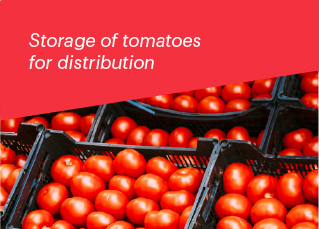Table of Contents

We can help you in the storage, transportation and preservation of tomatoes and all kinds of vegetables. This is one of the most important vegetables worldwide, and it is said to have originated from South America. We are talking about a vegetable widely known worldwide for the great diversity it holds.
Origin and varieties of tomato
The origin of this vegetable comes from South America. It is said that it took place in South America, from where the Spanish introduced it to Europe in the 15th century as an ornamental plant, but it did not become a relevant crop until the 20th century.
Mainly we distinguish multiple varieties of tomato, according to the type of fruit and plant. We will highlight those that we consider the most relevant within the Spanish market, from the perspective of Antonio Marco’s clients:
- Valencian: As its name indicates, it comes from the Valencian Community. It is one of the largest varieties. They are meaty and intense flavor.
- Raf: it was created from other varieties to be able to be resistant to a fungus that affected the cultivation of these varieties. It has a strong contrast between sour and sweet taste, its shape is
- irregular, and it is usually green or dark green in color.
- Pear: it is named for its elongated shape. Its flavor is quite sweet, and hard skin. It is usually used for canning and dehydrating.
- Muchamiel: comes from Mutxamel, Alicante. It has a medium size, thin skin, green with reddish parts that increase as it matures. Its flavor is soft and sweet.
- Marglobe: It is one of the most common in stores. It is usually used for gazpacho due to its colour, size and fleshiness, and it does not contain too many seeds.
- Ox heart: Receives this name for its large size and shape. Its flavor is soft, its pulpy meat and it does not contain too many seeds.
- Cherry: They are miniature tomatoes, so, like the larger ones, there are different types, due to their color and shape.
Season and harvest of tomato for its subsequent conservation
This vegetable is available all year round, since it is grown all over the world, using different growing cycles, depending on the varieties. It is true that the use of cold rooms is very important for the conservation of vegetables in periods of low demand, or excess supply.
As far as tomato harvesting in Spain is concerned, we find ourselves with different diseases and problems:
- Diseases:
- black rot
- sour rot
- cottony rot
- gray rot
- bacterial soft rot
- Issues:
- softening
- Give us cold
Next, we will explain a series of key measures for cold storage of tomatoes.
 Tomato storage for distribution
Tomato storage for distribution
The importance of a logistic warehouse for the conservation of tomatoes is key. This vegetable, one of the most consumed in the world, is very important for all cold storage companies in the Levante area. With around 36,000 tons produced, Spain is the seventh world country in tomato production.
Countries such as China, the United States, Turkey and Egypt have gained weight in the European market, where they rely on logistics warehouses where they keep the tomato in merchandise refrigerated chambers to extend its useful life, and later, to be distributed in times when Spanish production does not meet the demand
Tomatoes, a perishable food, require a storage temperature between 10-15°C, depending on the customer’s requirements, this may vary. A key element in good tomato conservation is; Harvest at the right maturity. Low temperatures and high relative humidity around 90-95% reduce transpiration, slow down water loss, and in turn reduce the development of pathogens, helping to extend the life of the tomato.
Tomato transport in Spain and the rest of Europe
Tomato is a commodity whose main export destinations are usually:
- Tomato transport, Spain to Germany
- Tomato transport, Spain to France
- Tomato transport, Spain to the Netherlands
- Transport of tomato, Spain to Italy
- Transport of tomato, Spain to Belgium
The ideal temperature for transporting tomatoes is between 10-15ºC continuously, although it is true that tomatoes do not suffer much from temperature changes in the short term. The transport companies of Alicante and Murcia are focused on the transport of tomatoes to international markets. We are companies that are close to the product, and our know-how, which we have achieved thanks to our years of experience.
We have seen that temperature-controlled storage is key, but this work will mean nothing if we do not carry out optimal refrigerated freight transport. Antonio Marco is clear that his logistics in Alicante is more than prepared to carry out this task, thanks to its Alicante logistics center located in Granada, Alicante. Antonio Marco is a company that can carry out the activities of: transport, storage and conservation of tomatoes.
At Antonio Marco we can help you transport and preserve tomatoes with a guarantee and exceptional service.

 Tomato storage for distribution
Tomato storage for distribution